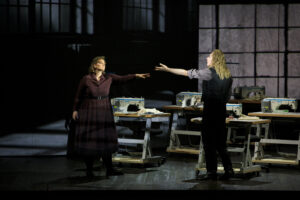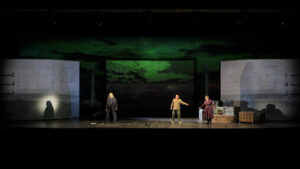When I was a teenager, I loved Tadeusz Różewicz’s now rather forgotten play The Laocoon Group – not least because I was lucky enough to see a production at Warsaw’s Teatr Współczesny directed by Zygmunt Hübner and featuring an unequalled cast led by Zofia Mrozowska, Wiesław Michnikowski and Henryk Borowski. It was a frightfully funny performance, from which I will always remember the pretentious tirade of the Father, a representative of the so-called working intelligentsia, who, having returned from Italy, tells his family about the famous sculpture from the Vatican Museums, weaving quotations from Virgil, among other things, into his story. The problem is that he only saw a plaster copy of it, as the original had just been removed for restoration.
I had a vivid recollection of the scene from The Laocoon Group, when I received a message confirming my accreditation for a performance of Der fliegende Holländer at the Teatro Comunale di Bologna. It wasn’t until I read that I was to pick up my ticket at the entrance to the EuropAuditorium in Piazza Costituzione that I remembered that as of January the famous Sala Bibiena, and with it the entire theatre building, would be undergoing renovation for four years – roughly the length of the reconstruction work after the great fire of 1931, which ended with the rebuilding of the auditorium in its current horseshoe shape. Tough luck: I had to get over the fact I would not be seeing the most famous “Wagnerian” stage in Italy. Not only the venue of the Italian premiere of Der fliegende Holländer and of the first performance of Lohengrin – which Verdi followed from a box with the score on his lap – but also the first theatre in the world to receive official permission from the Bayreuth Festival to stage Parsifal, on 1 January 1914, under the baton of Rodolfo Ferrari, with the phenomenal Giuseppe Borgatti in the title role and the Polish singer Helena Rakowska – the wife of Tullio Serafin – in the role of Kundry. An opera house headed by such music directors as Sergiu Celibidache and Riccardo Chailly in the past, and since last January by Oksana Lyniv – not just the first female conductor here, but also the first ever woman to be in charge of an opera company in Italy. One year before that Lyniv broke another taboo by conducting Der fliegende Holländer at the opening of the Wagner feast in Bayreuth, after 145 years of uninterrupted male reign at the helm of the local orchestra.
Scene from the Act 1. Photo: Andrea Ranzi
In August 2022 I had mixed feelings after a revival of the Bayreuth Holländer under her baton. I decided to verify my opinion in Bologna, choosing for the purpose a performance with the second cast in order not to be influenced by my impressions of the singers I had heard the previous season not just in Bayreuth, but also at Grange Park Opera in England. The first pleasant surprise came, when I dealt with the company’s very efficient press office. The second – when I picked up the superbly edited programme book for the production, with exhaustive documentation of past productions of Wagner’s opera at the Teatro Comunale and an extensive discography of the work, dating back to 1936. The third – after my first look inside the EuropAuditorium, a 1,700-seat theatre with a fairly deep orchestra pit and a fully equipped stage tower, located in the 1975 functionalist Palazzo di Congressi (its main designer was Melchiorre Bega, the architect behind the famous “golden high-rise” of the Axel Springer concern in Berlin). It may not be a dream venue for presenting Wagner’s works, but it does boast excellent, very selective acoustics, making it possible to honestly assess not only the soloists’ abilities, but also the overall interpretative concept for the piece.
However, I will start with the staging, as it seemed to be absent in Bologna, which is all the more surprising given that both the director Paul Curran and the set designer Robert Innes Hopkins are experienced opera people who have worked for years – successfully – on several continents. In addition, both are highly skilled at Personregie and creating a theatrical world in a relatively small space. Yet this time neither of them took into account the fact that the EuropAuditorium stage is shallow, but relatively wide, and, most importantly, that it does not provide intimate contact with the audience, seated in a vast and flat auditorium. The vision presented by Curran and Hopkins (in collaboration with the lighting director Daniele Naldi and the projection designer Driscoll Otto) gave the impression of being not so much minimalist as economical and, most significantly, imitative of the Florence staging of Der fliegende Holländer done four years earlier by Curran with a different set designer (Saverio Santoliquido). Images – almost identical to those in Florence – of the rolling sea and the ghostly attributes of the Dutchman’s ship were displayed in Bologna against a backdrop of three overlapping panels, in a space less well lit and less appealing to the audience’s imagination. In the second act, set – unconvincingly – in a contemporary industrial sewing room, projections partially replaced the fixed decoration from Santoliquido’s vision, and were supplemented by Caspar David Friedrich’s painting The Wanderer above the Sea of Fog (serving as a portrait of the legendary Dutchman) superimposed on the waves. Like four years ago the costumes were from an unspecified period. Several theatrical effects – including the pulling ashore of Daland’s invisible ship – were copied from the previous staging. There was no chemistry between the characters whatsoever. In the finale the Dutchman sneaked out through a gap in the middle screen, while Senta climbed to the top of the side panel and disappeared in the wings. This failed compromise between tradition and modernity was more reminiscent of a staged concert or amateur theatre performance, although, admittedly, it did not particularly bother the singers.
Sonja Šarić (Senta) and Anton Keremidtchiev (The Dutchman). Photo: Andrea Ranzi
They were, however, especially in the Act 1, hampered by the orchestra playing with a truly Verdian temperament and generally in a style more suitable for I vespri siciliani or Un ballo in maschera rather than any of Wagner’s scores. As an ardent admirer and researcher of archives – including regional archives – I listened to this performance with genuine emotion, relishing the virtuoso displays of the violin concertmaster, the tearful solos of the oboe and the repeated attacks of the brass. It would have been truly fascinating, if Lyniv had been able to give the whole at least a semblance of a consistent romantic narrative. Yet all doubts I had raised about her interpretation in Bayreuth were more than confirmed in Bologna. Lyniv is a genuine modernist, dissecting the piece into its constituent parts, extracting sometimes unexpected details from the texture – but she is unable to put them back together into a convincing story. Her conducting is sweeping, has real verve, but it works only in the most dazzling passages. Wherever the narrative requires lyricism and ability to read forgotten aesthetic codes – it loses its pulse, gets bogged down in meanderings of boredom and feigned emotion. Lyniv’s interpretations bring to mind monochromatic photographs in which it is impossible to see the forest from behind black and white trees. There is inhuman sharpness and surgical precision in them. There are no colours, chiaroscuro effects or logical dynamic and agogic contrasts.
That is why Anton Keremidtchiev, who is endowed with a small but very handsome baritone, shone as the Dutchman only in Act 3 – his chilling monologue “Die Frist ist um” was drowned in a sea of perfectly articulated but meaningless orchestral sounds. That is why Senta, portrayed by the very young and very musical Sonja Šarić, gave up after several attempts to make her famous ballad sway and sang it politely, evenly, to the beat imposed by the conductor. Goran Jurić must have looked up to Peter Rose from the first cast during rehearsals. Rose knows how to highlight the similarities between Daland and the equally ambiguous character of Rocco from Beethoven’s Fidelio, but Jurić lacked intonational and technical prowess in the role. I find it difficult to judge Alexander Schulz, who took on the role of Erik just days before the opening night; however, I did not expect a tenor singing with such a strong foreign accent and in a manner associated with verismo rather than Wagner’s youthful oeuvre. Despite her young age the Russian mezzo-soprano Marina Ogii has a voice that is too dilapidated even for the role of Mary. Paolo Antognetti gave a very decent performance as the Steersman: I’m referring here more to the sonorous, bronzy tone of his voice rather than to his interpretation of his character. The unquestionable hero of the performance was the Teatro Comunale chorus, prepared by its new master, Gea Garatti Ansini, and singing with perfectly produced, rich and beautifully rounded sound.
Anton Keremidtchiev, Alexander Schulz (Erik) and Sonja Šarić. Photo: Andrea Ranzi
Summing up my field research on Der fliegende Holländer as interpreted by Oksana Lyniv, I will return to the discussion of the two Gentlemen with the Customs Officers in Różewicz’s play: after an exchange of remarks about Kierkegaard, one of the Customs Officers, when asked about what is new in the country, waves his hand and says: “Disintegration, alienation, frustration, everything as it used to be”. I never thought I would have to go all the way to Bologna to find that out.
Translated by: Anna Kijak



